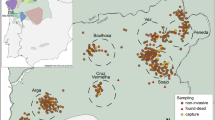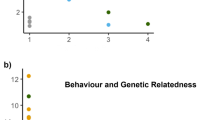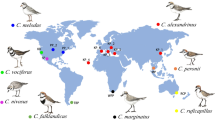Abstract
Leks have traditionally been considered as arenas where males compete to attract females and secure matings. Thus, direct fitness benefits mediated through competition between males to fertilize females have been considered to be the primary force driving the evolution of lekking behaviour1,2. Inclusive fitness benefits mediated through kin selection3 may also be involved in lek formation and evolution4,5, but to date this theory has been largely ignored. According to kin-selection theory, both reproducing and non-reproducing males may gain indirect inclusive fitness benefits. If females are attracted to larger leks, non-reproducing males add attractiveness to a lek, and therefore, in a genetically structured population, boost the reproductive success of kin. Theory predicts that the attractiveness of leks is plastic, and that males establish themselves on a lek in which the top male, in terms of reproductive success, is a close relative6. Here we show that in white-bearded manakins (Manacus manacus), for which larger leks are more attractive to females7,8 and so secure the maximum number of matings, there is extraordinary fine-scale genetic structure, with leks being composed of clusters of related kin. We propose that males establish themselves where they find relatives to such an extent that they form groups within leks, and that such behaviour is consistent with kin-selection theory to maximize reproductive success of the group.
This is a preview of subscription content, access via your institution
Access options
Subscribe to this journal
Receive 51 print issues and online access
$199.00 per year
only $3.90 per issue
Buy this article
- Purchase on Springer Link
- Instant access to full article PDF
Prices may be subject to local taxes which are calculated during checkout


Similar content being viewed by others
References
Höglund, J. & Alatalo, R. V. Leks (Princeton Univ. Press, Princeton, 1995).
Wiley, R. H. Lekking in birds and mammals: Behavioral and evolutionary issues. Adv. Study Behav. 20, 201–291 (1991).
Hamilton, W. D. The genetical evolution of social behaviour I. J. Theor. Biol. 7, 1–16 (1964 ).
Höglund, J., Alatalo, R. V., Lundberg, A., Rintamäki., P. T. & Lindell, J. Microsatellite markers reveal the potential for kin selection on black grouse leks. Proc. R. Soc. Lond. B 266, 813–816 (1999).
Petrie, M., Krupa, A. & Burke, T. Peacocks lek with relatives even in the absence of social and environmental cues. Nature 401, 155– 157 (1999).
Kokko, H. & Lindström, J. Kin selection and the evolution of leks: whose success do young males maximise? Proc. R. Soc. Lond. B 263, 919–923 ( 1996).
Lill, A. Social organization and space utilization in the lek-forming white-bearded manakin, M. manacus trinitatis Hartert. Z. Tierpsychol. 36, 513–530 (1974).
Kokko, H., Sutherland, W. J., Lindström, J., Reynolds, J. D. & Mackenzie, A. Individual mating success, lek stability, and the neglected limitations of statistical power. Anim. Behav. 56, 755–762 (1998).
Snow, D. W. A field study of the black and white manakin, Manacus manacus, in Trinidad. Zoologica 47, 65–104 (1962).
Lill, A. Sexual behavior of the lek forming white-bearded manakin (Manacus manacus trinitatis Hartert). Z. Tierpsychol. 36, 1–36 (1974).
Lynch, M. & Ritland, K. Estimation of pairwise relatedness with molecular markers. Genetics 152, 1753 –1766 (1999).
Sherman, P. W. Birds of a feather lek together. Nature 401, 119–120 (1999).
Sherman, P. W., Reeve, H. K. & Pfennig, D. W. in Behavioural Ecology An Evolutionary Approach 4th edn (eds Krebs, J. R. & Davies, N. B.) 69–96 (Blackwell, Oxford, 1997).
McDonald, D. B. & Potts, W. K. Cooperative display and relatedness among males in a lek-mating bird. Science 266, 1030–1032 (1994).
Acknowledgements
We thank C. Fitzjames, J. Johnston and T. Lievonen for help in the field, S. Griffith for advice and R. Dufva for help in the lab. The study was funded by the Swedish Natural Sciences Research Council (NFR) (to J.H.).
Author information
Authors and Affiliations
Corresponding author
Supplementary information
Rights and permissions
About this article
Cite this article
Shorey, L., Piertney, S., Stone, J. et al. Fine-scale genetic structuring on Manacus manacus leks. Nature 408, 352–353 (2000). https://doi.org/10.1038/35042562
Received:
Accepted:
Issue Date:
DOI: https://doi.org/10.1038/35042562
This article is cited by
-
Solitary versus group living lifestyles, social group composition and cooperation in otters
Mammal Research (2021)
-
Kin-dependent dispersal influences relatedness and genetic structuring in a lek system
Oecologia (2019)
-
Fine-scale genetic structure among greater sage-grouse leks in central Nevada
BMC Evolutionary Biology (2016)
-
No behavioural response to kin competition in a lekking species
Behavioral Ecology and Sociobiology (2016)
-
Crozier’s paradox revisited: maintenance of genetic recognition systems by disassortative mating
BMC Evolutionary Biology (2013)
Comments
By submitting a comment you agree to abide by our Terms and Community Guidelines. If you find something abusive or that does not comply with our terms or guidelines please flag it as inappropriate.



